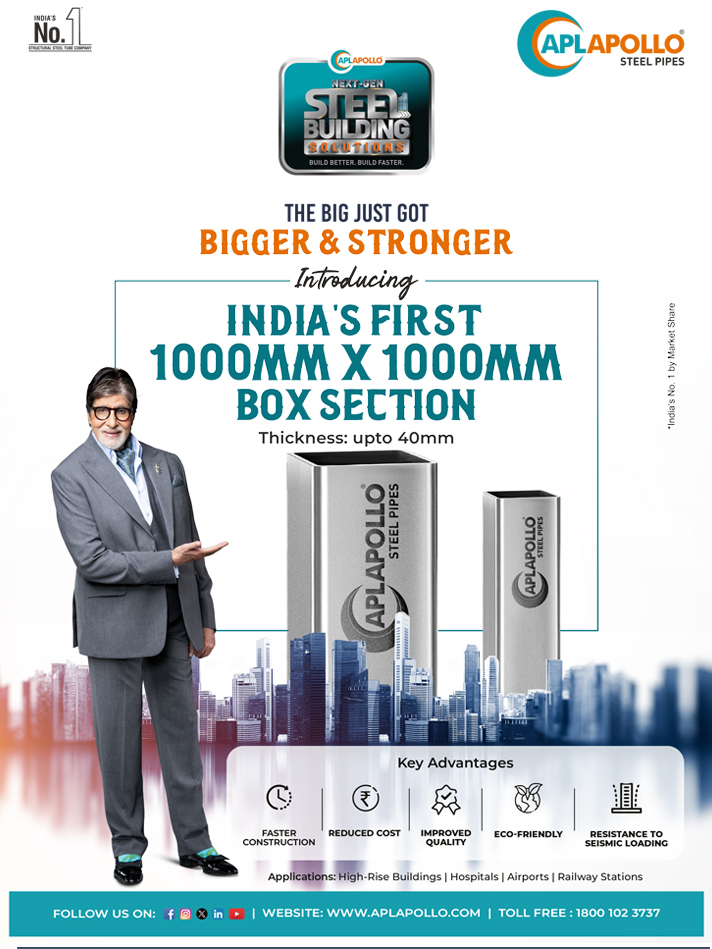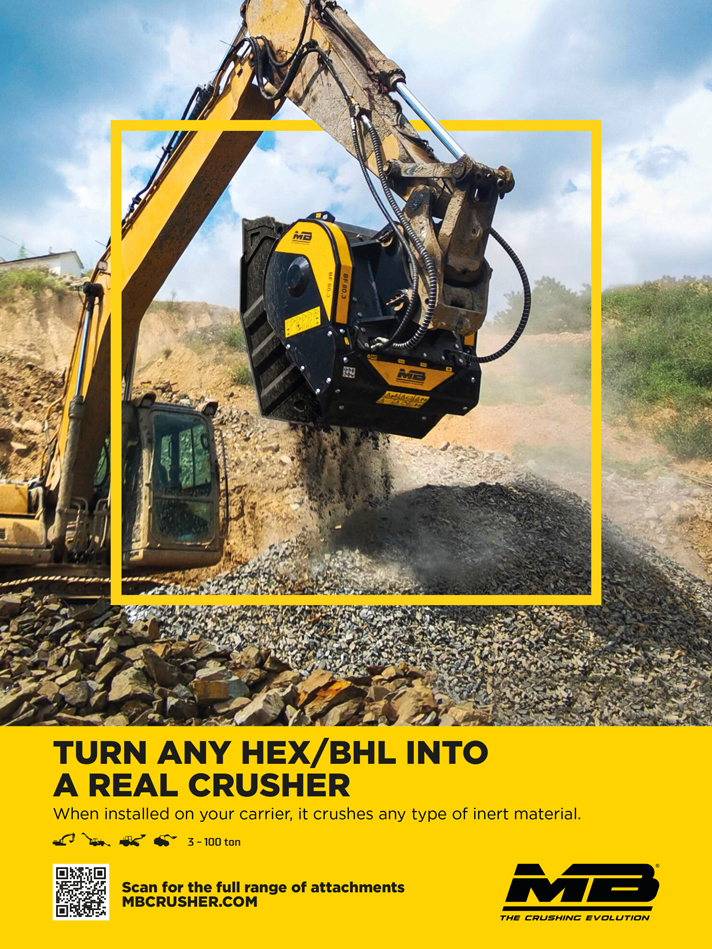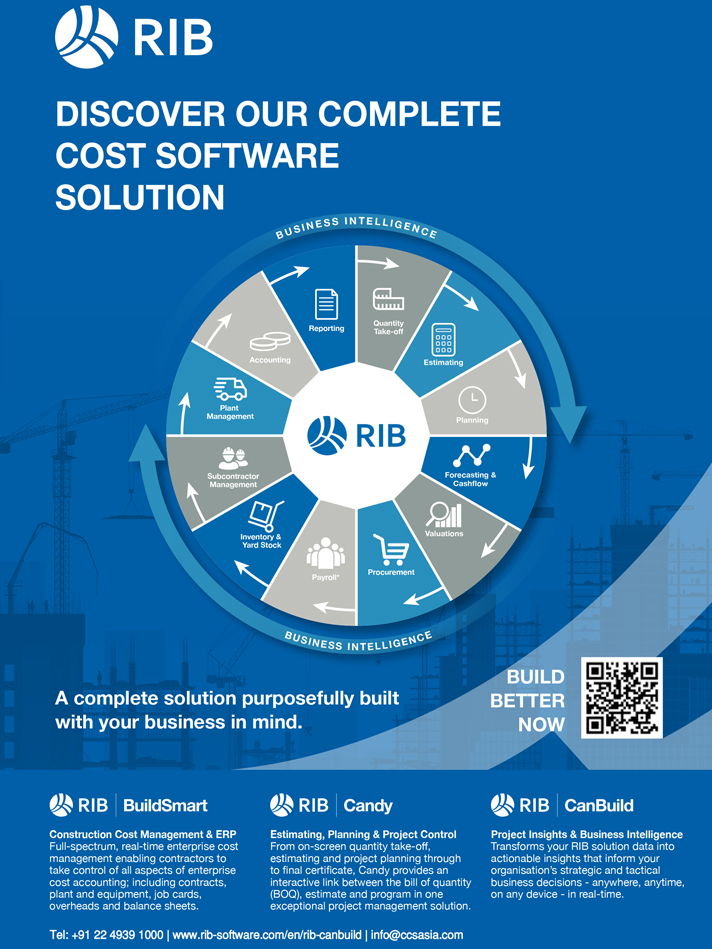CRANES – TOWER & MOBILE SMART & SUPERIOR
The Indian crane market was valued at $922 million in 2021, and is expected to reach $1,248 million by 2027, registering a CAGR of over 5.3%. While this is growth in figurative terms, recent innovations in smart design, technology and manufacturing are significantly impacting the growth of both Tower & Mobile Cranes market not only in India, but globally as well. These Smart Cranes are Modular, Adaptable and Intelligent. They are more compact and energy efficient to suit the needs of the growing construction landscape. Superseding the cranes of yesteryear, these Superior Cranes are enabling construction companies increase equipment uptime, save on maintenance & energy costs, enhance scalability and extend the life of their investments…. writes, PRERNA SHARMA.
According to Research & Markets report, the global crane market is likely to grow at a CAGR of 6.8% during 2022-2031. The market generated a revenue of around $33,000 million at the end of 2021 and is likely to produce revenue worth nearly $62,000 million by the end of 2031. The market growth is significantly driven by rising constructional activities and the growing need of housing. Moreover, higher prevalence of urbanization and increasing demand of all terrain cranes is expected to propel the market growth. The mobile crane is anticipated to garner the highest revenue of nearly $30,000 million by the end of 2031 by growing at a CAGR of 6.4% over the forecast period. The segment collected a revenue of nearly $16,000 million in 2021.
In the past few years, high economic growth has been seen in the construction industry in India owing to the high growth rate. Many heavy construction projects such as flyovers, railway projects, metro projects, and bridges have boosted the demand for heavy-duty mobile cranes over the past few years. The demand for mobile cranes is expected to increase, particularly for higher tonnage cranes used in several application segments. Apart from this, the use of mobile cranes is also growing in refinery expansion projects, and the renewable energy sector is also propelling the demand for mobile cranes. Furthermore, the rental industry plays a key role in the mobile crane segment of the market.
Fast Facts
- Facing challenges such as high cost of the equipment, setup time, and safety of the workers has always been one of the prime concerns of end users. Against this backdrop, some of the leading manufactures within the market are focusing on the development for enabling easy manoeuvrability of the tower cranes coupled with increasing the production capabilities.
- Due to their adaptability for medium to high-rise development projects and extended-duration needs, top-slewing cranes are in high demand. These cranes are designed to be stationery and rest on structural and steel bases to provide stability during weightlifting operations. The requirement to move big loads from one location to another in utility and construction applications is driving up demand for top-slewing models.
- The global mobile crane market was valued at $14,357.7 million in 2021, and is projected to reach $24,507.5 million by 2031, registering a CAGR of 5.3% from 2022 to 2031.
MOBILE CRANES
The global mobile crane market was valued at $14,357.7 million in 2021, and is projected to reach $24,507.5 million by 2031, registering a CAGR of 5.3% from 2022 to 2031, according to Research & Markets. Mobile cranes are designed for lifting heavy objects on construction, manufacturing, and other sites. Mobile cranes have self erection abilities, which make them suitable for use in compact urban spaces and construction sites. The mobility feature of mobile cranes boosts their demand over static cranes. Mobile cranes provide the advantage of easy transit from one job site to another, unlike fixed cranes. In addition, they require very less time for installation and set-up and have self-decking and un-decking features. In addition, mobile cranes can be remotely operated, which reduces the risk of accidents and fatalities caused due to collapsing of weight. Moreover, mobile cranes typically have hydraulic telescopic booms or lattice booms and can be further attached with hook or other load handling devices.
The integration of industry automation and remote operation has significantly increased their usability and operability, while keeping the cost of operation low. Furthermore, the introduction of hybrid cranes that are capable of operating on convention fuel as well as electricity has positively influenced the demand for mobile cranes. Moreover, the improvement in aftermarket services is also anticipated to drive the mobile crane market growth.
By boom type, the telescopic boom segment accounted for the highest mobile crane market share in 2021, owing to its ease of usability. According to the terrain type, all-terrain cranes have maximum contribution in the mobile crane market, mainly due to their versatility and high efficiency. In addition, all-terrain cranes provide high lifting capacity and superior mobility over rough as well as normal highways. Furthermore, wheel mounted cranes have high demand globally, owing to their compact size and easy manoeuvrability feature.
TOWER CRANES
A GM Insight report stated that Tower Crane Market size surpassed $4 billion in 2021 and is projected to exhibit around 5% CAGR from 2022 to 2030. Rapid urbanization and ongoing expansion of industrial and commercial sectors worldwide will boost the industry demand. To address affordability concerns associated with tower cranes, many companies are introducing rental services for construction projects. These models are gaining momentum as they help avoid initial investment costs as well as offer fewer maintenance requirements, no depreciation cost, and reduced repair costs. Additional benefits of these rental service include time-saving capabilities in applications such as transportation, on-site setup, and transportation.
The hammerhead tower crane market size is expected to witness around 7% growth rate between 2022 and 2030. These cranes are gaining traction owing to their ability to facilitate reliable handling of bulk materials and ensure accurate horizontal load movement. Increasing technological advancements in crane technology and the construction of smart city projects will fuel the demand for such tower cranes. The market revenue of bottom slewing cranes is anticipated to attain 4% gains through 2030. These cranes are widely used at private construction sites and are in high demand among contractors. A surge in low-rise and short-term construction projects that are backed by private and public organizations will complement the equipment utilization.
According to Mordor Intelligence report, with rapid urbanization, the need for tower cranes is expected to increase in the future. The 5T and 10T lifting capacity cranes are expected to be the most used type in construction activity, due to the broad spectrum of uses these cranes can offer. Also, most of the materials that need lifting from the crane falls under this category and has also led to these segments leading the market.
The availability of different designs for this lifting capacity category has attracted a lot of interest and attention from potential buyers and contractors of different agencies and countries. The increased demand for these machines in several sectors like energy, oil, and gas, and port-material handling requirements is another major advantage for this category of cranes. Also, the high tip hoisting capacity offered by the 10T capacity cranes is an attractive characteristic for buyers looking for heavyweight hoisting up over huge heights. The lower emissions from these cranes and the ease of usage in terms of adding and removing the crane bars for the flexible height of the crane is another advantage.
Advancing at the rapid pace
Technological advancements are a key trend gaining popularity in the cranes market. Automation is taking place in the cranes market to gain work efficiency, with the incorporation of anti-collision, zoning, and internet-based setup. Companies operating in the cranes market are utilizing advanced technologies such as artificial intelligence, machine learning, and computer vision for the development of autonomous cranes. These cranes’ movements are being monitored by operators in a control room using onboard cameras and a remote-control station. The key target of these new systems is to exclude the workforce from a potentially dangerous and challenging working environment involving enormous machinery and transported to the safety and comfort of a control room via remote crane operation.
In addition to remote monitoring, some new systems can also detect load weight and positioning, helping operators make smarter decisions relative to available space. Another innovation is a crane with optimized pulley rope angles, which extend the life of wire hoisting ropes. This makes the angles smaller, reducing wear on the rope. Smart systems also communicate the condition of wire ropes and recommend replacement when needed. Additionally, new cranes are smaller, reducing the need for expensive building renovations. Because smaller cranes can operate in much tighter spaces, they can position loads more precisely, as stated in Konecranes’ technical insights.
Keeping up with its innovative streaks, Liebherr is expanding its successful series of flat-top cranes with the new 300 EC-B 12 Fibre and 270 EC-B 12. Both machines are ideal for sites requiring heavy hoists and meet all the main requirements placed on a modern crane fleet. The 300 EC-B 12 Fibre features the Liebherr fibre rope and therefore delivers significantly better performance values than similar cranes with a steel rope. The fibre rope also has a much longer service life which means that the rope has to be changed less frequently. That makes operation even more economical and increases the crane’s availability. The 300 EC B 12 Fibre has a 70 metre jib and delivers a lifting capacity at the jib head of 3250 kgs. The “Tough Guys” have been designed for simple transport and erection, which also delivers major cost benefits for rental businesses. The counter-jib, slewing platform and jib segments can be carried to the site in just four transport units due to their smart stacking system. This also makes a major contribution to reducing greenhouse gases. The jib and counter-jib can be attached to the slewing platform easily, conveniently and safely. This is all made possible by Liebherr’s time-tested quick-release connectors. Depending on the requirements at the site, the jib can be extended or reduced in 2.5 metre sections.
Recently, XCMG “XGT15000-600S”, the world’s largest tower crane with 10 world first technologies, successfully rolled off the production line, achieving a new breakthrough in the field of bridge construction equipment. It is reported that the XGT15000-600S has a maximum lifting height of 400m and a maximum lifting weight of 600t, which will effectively solve the problems of heavy lifting components, high construction height and large operation span of the project. The XGT15000-600S has conquered over 20 of the world’s top technical bottlenecks with industry-leading overall technological capability. The pioneering dual-boom modular parallel combination technology has solved the manufacturing, installation and transportation problems of the super large lifting booms; the world’s first four-bar linkage double amplitude cooperative operation technology has solved the limited installation space and linkage design problems for 600 ton super rope capacity; and the first hoisting wire rope space layout technology has solved the problem of steel wire rope twisting with super high lifting height. The tower crane has also completed over 2,000 lifting tests and 1,440 hours of non-stop testing, heralding a new chapter of development for super-scale tower cranes. The XGT15000-600S was crafted based on the S series tower crane technology platform with core advantages including high safety level, intelligent technology, strong functionality, high quality, precise modules and excellent performance. The tower crane adopts the combined design of a flat head main tower, boom auxiliary tower and manned elevator.
The new CTT 222-10 is the newest in the line of city class flat top cranes that is to be offered by Terex Tower Cranes. The flat top tower crane is one that must be versatile as it works in a wide variety of job sites. “City class” refers to the design feature of the crane that ensures it is the best option for use within city settings, and this is the adaptability of the crane. Specifically, this refers to the premium design features such as Terex Power Plus (TPP) – a design feature that enables the crane to up the power by 10% when needed; Terex Power Match (TPM) – an economic addition to this fleet of cranes, this puts the crane into an energy saving mode; T-Link – the Terex telematics system that enables remote access to the fleet data at anytime and from anywhere via the web.
And very important the T-Torque – the Terex slewing technology that gives better control and increased precision over the crane slewing, including customizable settings, no matter the wind direction, tower system and jib configuration. This allows for extremely accurate control giving the operator complete personalization to how these controls are set up allowing for optimal control according to the operator themselves. These features allow the crane to perform as required in whatever setting it is used. Not only does the CTT 222-10 have these incredible features, but it also can be easily set up and erected with a 1.60m, 1.95m or 2.10m tower mast depending on the needs and requirements of the user and setting it’s in. This not only proves the versatility of the crane, but also the helps to balance the investment in this machine.
MTC 3625 Mobile Tower Crane from ACE is a self-erecting / self-folding mobile tower crane. Operations can be easily affected by a single operator through a remote control pod. The crane is mounted on a towable type trailer with compact dimensions for easy transportation. To minimise the dead weight for long distance transportation, the counter weight box is designed with trap doors to enable general ballast use as counter weight. The chassis design enables a short turning radius and easy positioning. An optional prime mover with a built-in 25KVA generator makes the machine totally independent of any outside electric source and a separate carrier vehicle. The crane uses only a part of the power and generator can be used for other side equipment like mixers, vibrators and job site lighting systems.
Comansa has expanded its range of luffing jib cranes, with the new hydraulic LCH300 model. Through this new hydraulic model, tower crane manufacturer has optimised the luffing mechanism to offer even greater performance and efficient assembly, in addition to a reduction of the radius when out of service. It has a reach of 25 to 60 metres, with configurations every five metres. The minimum working radius is 4 m and the minimum radius when out of service is 9 m. This is an important aspect to take into account in places with limited space, which are what luffing jib cranes are designed for. It has manual reeving changing of 1T (direct pulling) and 2T. The maximum load capacity is 8t with the 1T configuration and 16t with the 2T configuration. The maximum load at the jib end is 3,400 and 3,150kg, respectively. Thanks to the Effi-Plus technology, it is possible to increase the speed of the lifting mechanism without affecting consumption, which allows for reduced load cycles and improved productivity of the crane.
Moreover, Comansa has developed Crane Mate, a new digital solution for fleet management and crane monitoring. Crane Mate provides real time technical information, location, alerts and productivity and maintenance parameters for the tower cranes. Additionally, amongst other features, it facilitates seamless reporting & configuring events and recording machinery rental periods and/or the duration of construction projects.
Innovative horizons
Cranes are general-purpose lifting equipment widely used in construction industries. Crane operators must operate multiple levers simultaneously while checking the position of the load visually. In addition, cranes are affected by the boom deflection and wind, so it takes a long time to become a proficient crane operator. On the other hand, the number of skilled crane operators in Japan is declining due to the aging population. Taking the cognizance of the matter, DeepX and Tadano have started a joint research project of crane automation utilizing AI technology. The aim of this project is to improve safety at work sites by simplifying and automating mobile crane operations by utilizing AI technologies.
Mobile cranes are known to be one of the most difficult machines to operate on construction sites. Slewing and elevating motion in mobile cranes typically generates undesirable two-dimensional load-sway; therefore, crane operators must be highly skilled to suppress this sway upon completion of the point-to-point crane manoeuvre. DeepX and Tadano have therefore developed a control algorithm based on AI technology, leveraging simulator environment for controller optimization. Using this algorithm, the operator can safely and accurately move the load to the desired position while suppressing load sway.
Konecranes’ advanced technology provides high mechanical and electrical efficiency which reduces the crane’s overall energy consumption. Smart Features and process automation improve productivity, and further reduce energy consumption. For example, a fully automated crane with Konecranes DynAReg regenerative braking can recapture up to 30% of the crane’s braking energy, helping to decrease the overall energy consumption.
Manitowoc continues its expansion and investment in support services with the launch of CONNECT, a new digital platform launched at bauma 2022. It enables remote monitoring through an app-based system that gives owners and operators the ability to view real-time crane information, receive alerts, exchange data, and more with further functionality to be added in the future. The versatile CONNECT platform, with its wide-ranging capabilities, will advance fleet management, boost sustainability, streamline service and maintenance for users, and improve connectivity to cranes with the easy-to-use platform working across smartphones, tablets, and laptops. The new platform will be phased in, initially on Potain tower cranes and Grove all-terrain cranes. The company plans to add other product lines and brands in due course. CONNECT delivers an optimized user experience, assisting with set-up, simplifying maintenance, providing driver assistance systems, and more. Owners get real-time access to services and information with just a couple of taps on a screen.
The future of construction is high-tech and interconnected. That is why in addition to hardware product innovations, PALFINGER is increasingly using smart solutions that set new standards. The innovative Smart Control to control the crane tip unites the crane with the operator and revolutionizes the work process. Instead of moving up to three different levers, Smart Control only requires one to move the crane tip horizontally or vertically. The operator therefore only needs to specify the direction of the crane tip, while the intelligent technology combines the necessary crane movements to reach the target position exactly.
However, precision is required not only for crane control. The work steps involved in loading and unloading containers also require precision down to the last millimeter. Since container handling is one of the biggest challenges in everyday working life, PALFINGER has taken this on and developed an intelligent assistant system — Smart Loading Assist. The latest version of this semi-automatic system was displayed for the first time at bauma 2022. The Smart Loading Assist adds a 3D camera system, sensors and a high-performance computing unit to the hooklift. It works in a similar way to optical parking sensors and helps the operator to correctly position the hooklift in relation to the container. The integrated Obstacle Detection solution identifies any obstacles, or people, in the hazardous area and immediately warns the operator. The Smart Loading Assist also provides effective support during the unloading process to protect the surface on the ground, and the container.
A Triton study highlighted that growing trends in high-performance goods with lower carbon emissions and fuel economy have pushed companies to reinvent their product line and expand their presence in the mobile crane market. The increased eco-consciousness among manufacturers encourages the installation of flexible hydraulic systems and multimode power output functions. This helps reduce crane fuel consumption and makes them more responsive to changing trends. As mentioned in one of Konecranes’ technical insights, “New, smaller cranes are also designed to be more energy efficient. New crane technology cycles energy back into the power grid, which greatly mitigates warehouse energy consumption and costs. Some cranes are even manufactured with recyclable materials, supporting a company’s goal of being more environmentally responsible.” With all these interesting developments in the offing, the cranes market is poised for a great leap ahead.















